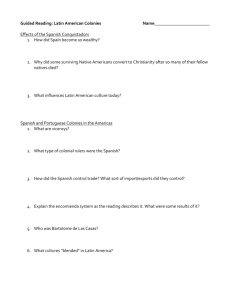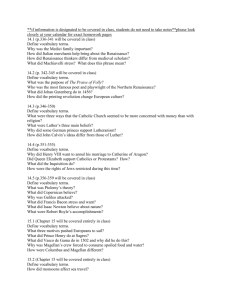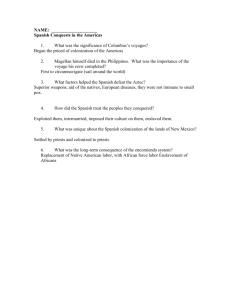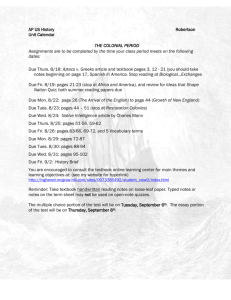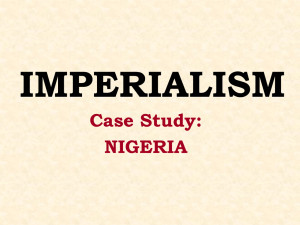Social structure of Colonial Latin America
advertisement
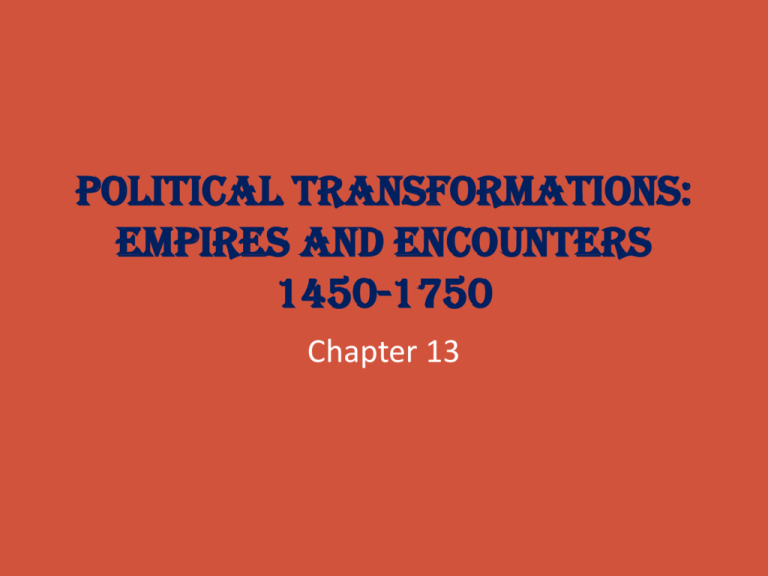
Political Transformations: Empires and Encounters 1450-1750 Chapter 13 Colonial Societies in the Americas • Spanish, Portuguese, British, French • Wholly new societies • Mercantilism: Colonies provided markets for goods and bullion. • Comparisons? – Catholic Spain and Protestant England – Type of economy – Urbanized Mesoamerican and Andean natives versus rural villages of North America – Role of women Spanish Colonies • Long before British and French • Economic foundation: commercial agriculture, silver and gold mining • Encomienda: The Spanish crown granted to particular Spanish settlers a number of local native people from whom they could require labor, gold, or agricultural produce and to whom they owed “protection” and instruction in the Christian faith. • Repartimiento/Mita: Same but with more control from the Spain, seen more as a tax/tribute, a certain % of natives were required to work for the estate owners for a certain amount of days • Hacienda: The owners of the large estates directly employed native workers. Social Structure of Colonial Latin America Chapter 13 Colonial Latin American Caste System • When Spanish and Portuguese colonies were established in central and south America a caste system formed. (castas) • One’s social class was directly tied to how “pure” his blood was and his place of birth. • The kings wanted to keep the colonies under their control and only have “loyal” people in office. Peninsulares Creoles Mestizos Mulattoes Amerindians Zambos Africans Peninsulares • “pure blood” ??? • From the Iberian Peninsula • Highest social class and the only class which could hold high office (church, military, administrative) • Spain wanted to keep loyalty of colonial leaders. Creoles • • • • • Born in Americas Land-owning Elite Could not hold highest positions In 1800s will rebel against peninsulares in wars of independence Mestizos • Of Spanish and Amerindian descent • Spanish and Portuguese men married native women and had families. Mulattoes = Spanish and African descent Zambos = Amerindian and African descent Africans • Many Africans were brought over from Africa to the colonies as slaves. • Some of these Africans would escape from a plantation and find their way to native villages. • Natives were usually sympathetic to the African people. Factions by Fractions • There were various levels in society, in between the main groups, based on blood quantum. Example: Castizos = ¾ European, no more than ¼ Amerindian • Derogatory Slurs Comparisons • Spanish and Portuguese colonies differed in that Africans were not a huge factor in Spanish colonial society but were in Portuguese society. • North American colonization was different in that women were colonists. There was not a shortage of women like in Meso and South America. Less racial mixing. • In North America three main groups: white, red and black; in Spanish and Portuguese colonies many mixed-race groups Settler Colonies in North America • Many British settlers wanted to escape Old World society and start over, not recreate what they had. • They could escape class restrictions of England. • More British settlers came to New World than Spanish or Portuguese. • Protestants not as interested in spreading Christianity as Catholics, but provided more literacy. • More local self-government, joint-stock companies and royal charters. British crown relatively unconcerned with colonies. Russian Empire • From Moscow to world’s largest state (15001800) • Brought the steppes and Siberia under its control • Submission to Tsar, yasak (tribute), and Christianity • Settlers put pressure on pastoralists/nomads • Russified Russian Empire • Became multi-ethnic through conquest (Slavs, pastoralists, Siberians) • Wealth in agriculture, furs, mineral deposits • Peter the Great: 1689-1725, westernization and modernization • Catherine the Great: 1762-1796, Enlightened despot Chinese Empire • Stopped possible maritime expansion but grew empire to the north and west • Qing dynasty or Manchu (1644-1912), they were from Manchuria and had conquered the Chinese • Brought Mongolia, Xinjiang, and Tibet under Chinese control or “unified” • Treaty of Nerchinsk (1689) with Russia to set boundary • Court of Colonial Affairs, local rulers • Change in that area: not cosmopolitan, nomadic pastoralists removed from world stage Mughal Empire in India • Rare period of political unity, 1526-1707 • Divided between Muslims and Hindus • Akbar: had tolerance toward Hindu majority, married Hindu princess, put Hindus in politicalmilitary elite, built temples, lessened restrictions on women, removed jizya/tax, House of Worship, Indian-Persian-Turkic culture • Opposition from Shayk Ahmad Sirhindi: it is the women’s fault • Aurangzeb: reversal of Akbar’s policy • Opposition movements weakened India Ottoman Empire • The “Sword of Islam”: conquered and defending Islam • Women had many rights, more than Europeans • Balkans: Christian majority, mostly tolerance, devshirme • Europeans worried about a Muslim takeover, Suleiman

